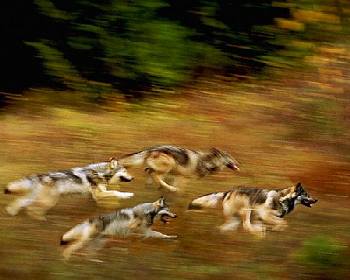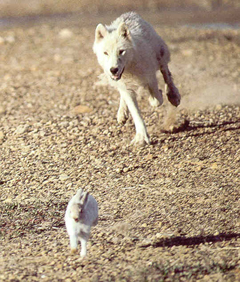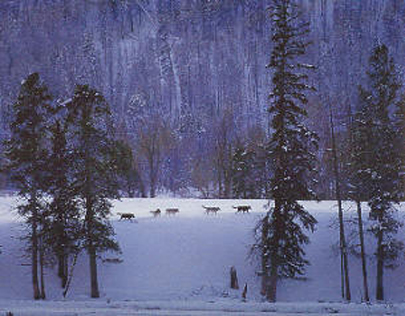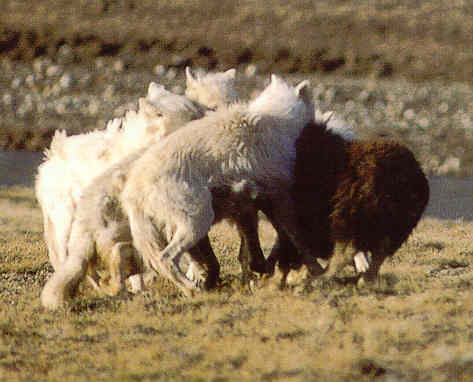The Chase
|

Once a weak individual is selected by a pack it is usually brought down
after a chase. Usually the chases are short.
Actions and reactions
of a hunting wolf pack are dependent on many thingss, including how
hungry they are, which prey species they are hunting, and, the reaction
of their targeted prey. Prey that runs is usually chased while prey
that stands its ground may be able to bluff its pursuers.
Wolves aften maneuver around their standing prey, sizing it up and
trying to detect weaknesses. Which shows you how smart wolves are.
Moose or musk oxen can easily inflict serious wounds to attacking
wolves, sometimes fatal ones. Cracked ribs, open wounds, and even broken
legs are a major risk for the hunters. A man named Barry Holstun
Lopez, who is in Of Wolves And Men, confirms that wolves use
various strategies when hunting. Although the data is still unclear, it
is known that an occasion, wolves employ what seems to be conscious
strategy - sending out one or two animals to herd prey into an ambush.
As previously stated, wolves vary their tactics slightly to hunt each species
of prey, adapting primarily to terrain. They prefer to attack sheep from
above. They may split up to skirt both sides of an island in a frozen
lake and then flush caribou or deer toward the island's tip. When
antelope were abundant, wolves reputedly lay low in the grass, switching
their tails from side to side to attract the curious animals over. They
have been abserved herding buffalo onto lake ice where the huge animals
lose their footing, a practice they still use to bring down elk.

The flight of the prey during the encounter stage of the hunt almost always results in an immediate rush. The rush is the most critical stage of the hunt. If the wolves fail to get close to their quarry during this stage, the prey runs off at top speed and the predators may never get close to it.
The final stage of the hunt is the chase, which is really a continuation of the rush, in which the prey fless and the wolves follow. If wolves catch up to their quarry, they may attack. If they fall behind, they give up quickly. Although the pursuit sometimes goes on for miles, it usually covers a shorter distance and lasts only a few minutes. And so a wolves pursuit doesn't last as long as some people seem to think. I know that when I first started learning about wolves I believed they would chase their prey for days and on into the night. But known as you see, I have learned differently.

Here is a little history on how wolves kill there prey.
Although both history and mythology is full of accounts of wolves
hamstringing their prey (slashing the tendons in their hind legs
so they cannot run), these stories are pure fiction. The actual death
of the prey usually results from massive blood loss, shock, or both.
With smaller prey, such as the rabbit, a neck bit will often snap
the backbone. The musk oxen calf in the picture is being attacked
in the nose, ears, and other parts of the head.
Below is a link to a fun picture you just must see!
Click me!
